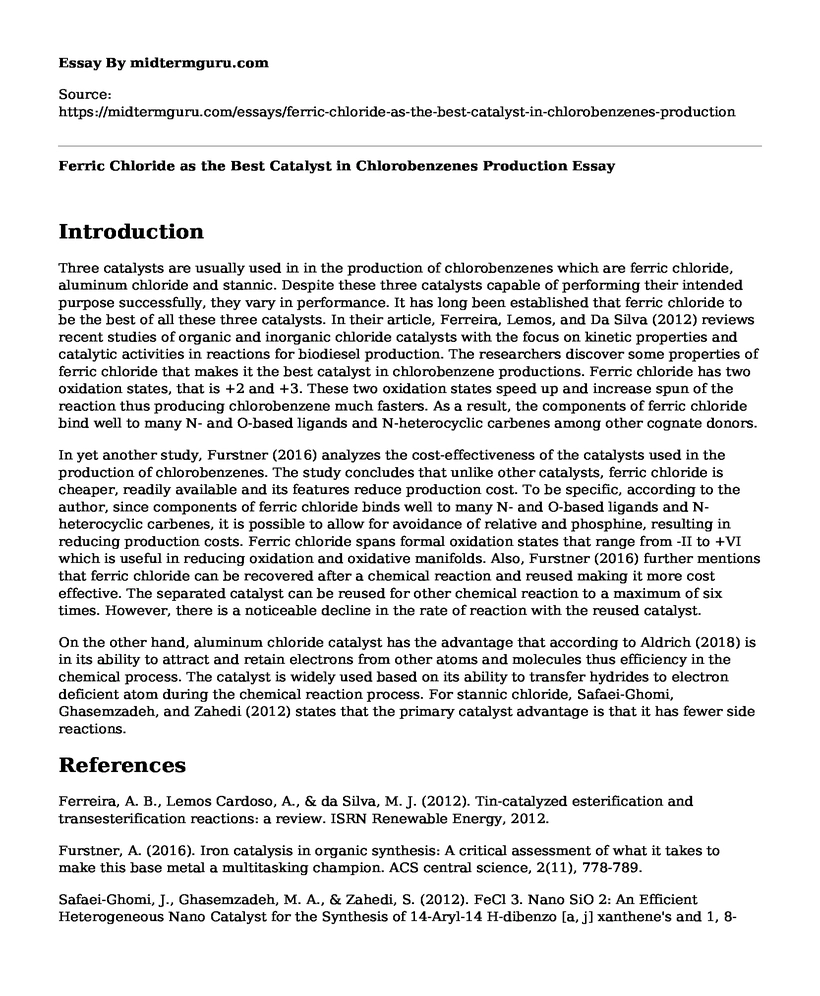Introduction
Three catalysts are usually used in in the production of chlorobenzenes which are ferric chloride, aluminum chloride and stannic. Despite these three catalysts capable of performing their intended purpose successfully, they vary in performance. It has long been established that ferric chloride to be the best of all these three catalysts. In their article, Ferreira, Lemos, and Da Silva (2012) reviews recent studies of organic and inorganic chloride catalysts with the focus on kinetic properties and catalytic activities in reactions for biodiesel production. The researchers discover some properties of ferric chloride that makes it the best catalyst in chlorobenzene productions. Ferric chloride has two oxidation states, that is +2 and +3. These two oxidation states speed up and increase spun of the reaction thus producing chlorobenzene much fasters. As a result, the components of ferric chloride bind well to many N- and O-based ligands and N-heterocyclic carbenes among other cognate donors.
In yet another study, Furstner (2016) analyzes the cost-effectiveness of the catalysts used in the production of chlorobenzenes. The study concludes that unlike other catalysts, ferric chloride is cheaper, readily available and its features reduce production cost. To be specific, according to the author, since components of ferric chloride binds well to many N- and O-based ligands and N-heterocyclic carbenes, it is possible to allow for avoidance of relative and phosphine, resulting in reducing production costs. Ferric chloride spans formal oxidation states that range from -II to +VI which is useful in reducing oxidation and oxidative manifolds. Also, Furstner (2016) further mentions that ferric chloride can be recovered after a chemical reaction and reused making it more cost effective. The separated catalyst can be reused for other chemical reaction to a maximum of six times. However, there is a noticeable decline in the rate of reaction with the reused catalyst.
On the other hand, aluminum chloride catalyst has the advantage that according to Aldrich (2018) is in its ability to attract and retain electrons from other atoms and molecules thus efficiency in the chemical process. The catalyst is widely used based on its ability to transfer hydrides to electron deficient atom during the chemical reaction process. For stannic chloride, Safaei-Ghomi, Ghasemzadeh, and Zahedi (2012) states that the primary catalyst advantage is that it has fewer side reactions.
References
Ferreira, A. B., Lemos Cardoso, A., & da Silva, M. J. (2012). Tin-catalyzed esterification and transesterification reactions: a review. ISRN Renewable Energy, 2012.
Furstner, A. (2016). Iron catalysis in organic synthesis: A critical assessment of what it takes to make this base metal a multitasking champion. ACS central science, 2(11), 778-789.
Safaei-Ghomi, J., Ghasemzadeh, M. A., & Zahedi, S. (2012). FeCl 3. Nano SiO 2: An Efficient Heterogeneous Nano Catalyst for the Synthesis of 14-Aryl-14 H-dibenzo [a, j] xanthene's and 1, 8-Dioxo-octahydro-xanthenes under Solvent-free Conditions. South African Journal of Chemistry, 65(1), 191-195.
Sigma-Aldrich. (2018). Aluminum Catalysts | Sigma-Aldrich. Retrieved from https://www.sigmaaldrich.com/chemistry/chemistry-products.html?TablePage=16257686
Cite this page
Ferric Chloride as the Best Catalyst in Chlorobenzenes Production. (2022, Aug 18). Retrieved from https://midtermguru.com/essays/ferric-chloride-as-the-best-catalyst-in-chlorobenzenes-production
If you are the original author of this essay and no longer wish to have it published on the midtermguru.com website, please click below to request its removal:
- The Demographic Transition Model - Essay Sample
- Essay on Complexity Science and Chaos Theory in Healthcare Systems
- Effective and Reflective Practices in Mathematics - Paper Example
- Gentrification of New York and Mumbai as Global Cities - Research Paper Example
- Paper Example on Physical Anthropology
- Role of Mathematics in History - Essay Sample
- Environmental Pollution: A Critical Threat to Human & Planet - Research Paper







